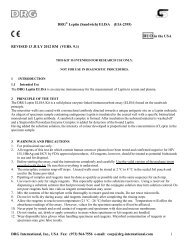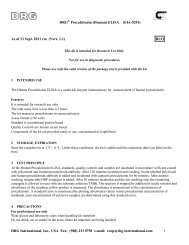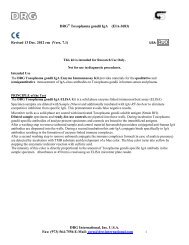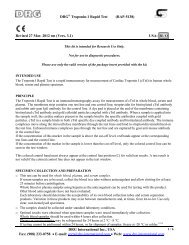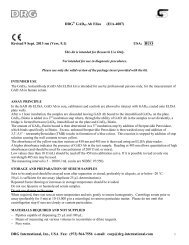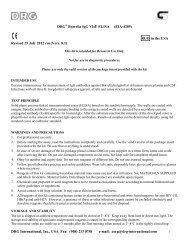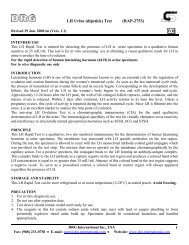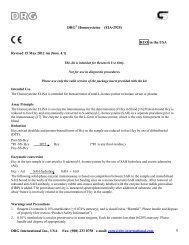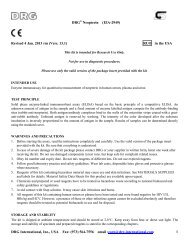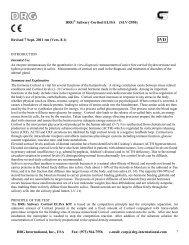DRG Free Estriol (EIA-1612) Revised 4 June ... - DRG International
DRG Free Estriol (EIA-1612) Revised 4 June ... - DRG International
DRG Free Estriol (EIA-1612) Revised 4 June ... - DRG International
You also want an ePaper? Increase the reach of your titles
YUMPU automatically turns print PDFs into web optimized ePapers that Google loves.
<strong>DRG</strong> ® <strong>Free</strong> <strong>Estriol</strong> (<strong>EIA</strong>-<strong>1612</strong>)<br />
<strong>Revised</strong> 4 <strong>June</strong> 2013 rm (Vers. 10.1)<br />
IVD<br />
1 INTRODUCTION<br />
1.1 Intended Use<br />
The <strong>DRG</strong> <strong>Free</strong> <strong>Estriol</strong> ELISA is an enzyme immunoassay for the quantitative in vitro diagnostic measurement of free<br />
estriol (unconjugated estriol) in serum during the second half of pregnancy<br />
1.2 Summary and Explanation<br />
<strong>Estriol</strong> (E3) is the major estrogen formed by the fetoplacental unit during pregnancy. Unconjugated E3 passes through the<br />
placenta into the maternal circulation, where it is rapidly converted into glucuronide and sulfate derivatives to facilitate its<br />
excretion. The half-life of estriol in the maternal bloodstream is only 20-30 minutes. Its measurement, therefore offers a<br />
convenient and quick evaluation of current fetal status. Plasma estriol levels increase steadily throughout pregnancy and<br />
most rapidly during the third trimester (28-40 weeks). A sudden decrease in fetoplacental E3 production will result in a<br />
rapid fall in unconjugated E3 in the maternal serum. There are several potential advantages to measuring unconjugated E3<br />
rather than total serum or urinary E3. Unconjugated estriol levels are free from effects related to maternal renal or hepatic<br />
disease, and are not altered by the administration of certain antibiotics. Unconjugated E3 more accurately reflects fetal<br />
outcome in diabetic pregnancies - and since no hydrolysis of unconjugated E3 is required, a more rapid tumaround for the<br />
test result is possible<br />
2 PRINCIPLE OF THE TEST<br />
The <strong>DRG</strong> <strong>Free</strong> <strong>Estriol</strong> ELISA Kit is a solid phase enzyme-linked immunosorbent assay (ELISA), based on the principle of<br />
competitive binding.<br />
The microtiter wells are coated with a polyclonal [rabbit] antibody directed towards an antigenic site on the <strong>Estriol</strong><br />
molecule. Endogenous <strong>Estriol</strong> of a patient sample competes with an <strong>Estriol</strong>-horseradish peroxidase conjugate for binding<br />
to the coated antibody. After incubation the unbound conjugate is washed off.<br />
The amount of bound peroxidase conjugate is inversely proportional to the concentration of <strong>Estriol</strong> in the sample. After<br />
addition of the substrate solution, the intensity of colour developed is inversely proportional to the concentration of <strong>Estriol</strong><br />
in the patient sample.<br />
<strong>DRG</strong> <strong>International</strong>, Inc., USA Fax: (973) 564-7556 e-mail: corp@drg-international.com 1
<strong>DRG</strong> ® <strong>Free</strong> <strong>Estriol</strong> (<strong>EIA</strong>-<strong>1612</strong>)<br />
<strong>Revised</strong> 4 <strong>June</strong> 2013 rm (Vers. 10.1)<br />
IVD<br />
3 WARNINGS AND PRECAUTIONS<br />
1. This kit is for in vitro diagnostic use only. For professional use only.<br />
2. All reagents of this test kit which contain human serum or plasma have been tested and confirmed negative for HIV<br />
I/II, HBsAg and HCV by FDA approved procedures. All reagents, however, should be treated as potential biohazards<br />
in use and for disposal.<br />
3. Before starting the assay, read the instructions completely and carefully. Use the valid version of the package insert<br />
provided with the kit. Be sure that everything is understood.<br />
4. The microplate contains snap-off strips. Unused wells must be stored at 2 °C to 8 °C in the sealed foil pouch and<br />
used in the frame provided.<br />
5. Pipetting of samples and reagents must be done as quickly as possible and in the same sequence for each step.<br />
6. Use reservoirs only for single reagents. This especially applies to the substrate reservoirs. Using a reservoir for<br />
dispensing a substrate solution that had previously been used for the conjugate solution may turn solution coloured.<br />
Do not pour reagents back into vials as reagent contamination may occur.<br />
7. Mix the contents of the microplate wells thoroughly to ensure good test results. Do not reuse microwells.<br />
8. Do not let wells dry during assay; add reagents immediately after completing the rinsing steps.<br />
9. Allow the reagents to reach room temperature (21-26°C) before starting the test. Temperature will affect the<br />
absorbance readings of the assay. However, values for the patient samples will not be affected.<br />
10. Never pipet by mouth and avoid contact of reagents and specimens with skin and mucous membranes.<br />
11. Do not smoke, eat, drink or apply cosmetics in areas where specimens or kit reagents are handled.<br />
12. Wear disposable latex gloves when handling specimens and reagents. Microbial contamination of reagents or<br />
specimens may give false results.<br />
13. Handling should be done in accordance with the procedures defined by an appropriate national biohazard safety<br />
guideline or regulation.<br />
14. Do not use reagents beyond expiry date as shown on the kit labels.<br />
15. All indicated volumes have to be performed according to the protocol. Optimal test results are only obtained when<br />
using calibrated pipettes and microtiter plate readers.<br />
16. Do not mix or use components from kits with different lot numbers. It is advised not to exchange wells of different<br />
plates even of the same lot. The kits may have been shipped or stored under different conditions and the binding<br />
characteristics of the plates may result slightly different.<br />
17. Avoid contact with Stop Solution containing 0.5 M H 2 SO 4 . It may cause skin irritation and burns.<br />
18. Some reagents contain Proclin 300, BND and/or MIT as preservatives. In case of contact with eyes or skin, flush<br />
immediately with water.<br />
19. TMB substrate has an irritant effect on skin and mucosa. In case of possible contact, wash eyes with an abundant<br />
volume of water and skin with soap and abundant water. Wash contaminated objects before reusing them. If inhaled,<br />
take the person to open air.<br />
20. Chemicals and prepared or used reagents have to be treated as hazardous waste according to the national biohazard<br />
safety guideline or regulation.<br />
21. For information on hazardous substances included in the kit please refer to Material Safety Data Sheets.<br />
Material Safety Data Sheets for this product are available upon request directly from <strong>DRG</strong>.<br />
<strong>DRG</strong> <strong>International</strong>, Inc., USA Fax: (973) 564-7556 e-mail: corp@drg-international.com 2
<strong>DRG</strong> ® <strong>Free</strong> <strong>Estriol</strong> (<strong>EIA</strong>-<strong>1612</strong>)<br />
<strong>Revised</strong> 4 <strong>June</strong> 2013 rm (Vers. 10.1)<br />
IVD<br />
4 REAGENTS<br />
4.1 Reagents provided<br />
1. Microtiterwells, 12 x 8 (break apart) strips, 96 wells;<br />
Wells coated with anti-<strong>Estriol</strong> antibody (polyclonal).<br />
2. Standard (Standard 0-5), 6 vials, 1 mL, ready to use;<br />
Concentrations: 0 - 0.3 - 1.2 – 4.0 - 15 - 40 ng/mL<br />
3. Control Low & High, 2 vials, 1 mL each, ready to use;<br />
For control values and ranges please refer to vial label or QC-Datasheet.<br />
Contain non-mercury preservative.<br />
4. Enzyme Conjugate, 1 vial, 14 mL, ready to use,<br />
<strong>Estriol</strong> conjugated to horseradish peroxidase;<br />
Contains non-mercury preservative.<br />
5. Substrate Solution, 1 vial, 14 mL, ready to use,<br />
Tetramethylbenzidine (TMB).<br />
6. Stop Solution, 1 vial, 14 mL, ready to use,<br />
contains 0.5 M H 2 SO 4,<br />
Avoid contact with the stop solution. It may cause skin irritations and burns.<br />
7. Wash Solution, 1 vial, 30 mL (40X concentrated),<br />
see „Preparation of Reagents“.<br />
Note: Additional Standard 0 for sample dilution is available upon request.<br />
4.2 Materials required but not provided<br />
A microtiter plate calibrated reader (450 ± 10 nm) (e.g. the <strong>DRG</strong> Instruments Microtiter Plate Reader).<br />
Calibrated variable precision micropipettes.<br />
Absorbent paper.<br />
Distilled or deionized water<br />
Timer<br />
Semi logarithmic graph paper or software for data reduction<br />
4.3 Storage Conditions<br />
When stored at 2 °C to 8 °C unopened reagents will retain reactivity until expiration date. Do not use reagents beyond this<br />
date.<br />
Opened reagents must be stored at 2 °C to 8 °C. Microtiter wells must be stored at 2 °C to 8 °C. Once the foil bag has<br />
been opened, care should be taken to close it tightly again.<br />
Opened kits retain activity for two months if stored as described above.<br />
4.4 Reagent Preparation<br />
Bring all reagents and required number of strips to room temperature prior to use.<br />
<strong>DRG</strong> <strong>International</strong>, Inc., USA Fax: (973) 564-7556 e-mail: corp@drg-international.com 3
<strong>DRG</strong> ® <strong>Free</strong> <strong>Estriol</strong> (<strong>EIA</strong>-<strong>1612</strong>)<br />
<strong>Revised</strong> 4 <strong>June</strong> 2013 rm (Vers. 10.1)<br />
IVD<br />
Wash Solution<br />
Add deionized water to the 40X concentrated Wash Solution.<br />
Dilute 30 mL of concentrated Wash Solution with 1170 mL deionized water to a final volume of 1200 mL.<br />
The diluted Wash Solution is stable for 2 weeks at room temperature.<br />
4.5 Disposal of the Kit<br />
The disposal of the kit must be made according to the national regulations. Special information for this product is given in<br />
the Material Safety Data Sheet.<br />
4.6 Damaged Test Kits<br />
In case of any severe damage to the test kit or components, <strong>DRG</strong> has to be informed in writing, at the latest, one week<br />
after receiving the kit. Severely damaged single components should not be used for a test run. They have to be stored until<br />
a final solution has been found. After this, they should be disposed according to the official regulations.<br />
5 SPECIMEN COLLECTION AND PREPARATION<br />
Serum should be used in this assay.<br />
Do not use haemolytic, icteric or lipaemic specimens.<br />
Please note: Samples containing sodium azide should not be used in the assay.<br />
5.1 Specimen Collection<br />
Serum:<br />
Collect blood by venipuncture (e.g. Sarstedt Monovette for serum), allow to clot, and separate serum by centrifugation at<br />
room temperature. Do not centrifuge before complete clotting has occurred. Patients receiving anticoagulant therapy may<br />
require increased clotting time.<br />
5.2 Specimen Storage and Preparation<br />
Specimens should be capped and may be stored for up to 4 days at 2 °C to 8 °C prior to assaying.<br />
Specimens held for a longer time ( least one year) should be frozen only once at -20 °C prior to assay. Thawed samples<br />
should be inverted several times prior to testing.<br />
<strong>DRG</strong> <strong>International</strong>, Inc., USA Fax: (973) 564-7556 e-mail: corp@drg-international.com 4
<strong>DRG</strong> ® <strong>Free</strong> <strong>Estriol</strong> (<strong>EIA</strong>-<strong>1612</strong>)<br />
<strong>Revised</strong> 4 <strong>June</strong> 2013 rm (Vers. 10.1)<br />
IVD<br />
5.3 Specimen Dilution<br />
If in an initial assay, a specimen is found to contain more than the highest standard, the specimens can be diluted with<br />
Standard 0 and reassayed as described in Assay Procedure.<br />
For the calculation of the concentrations this dilution factor has to be taken into account.<br />
Example:<br />
a) dilution 1:10: 10 µL Serum + 90 µL Standard 0 (mix thoroughly)<br />
b) dilution 1:100: 10 µL dilution a) 1:10 + 90 µL Standard 0 (mix thoroughly).<br />
6 ASSAY PROCEDURE<br />
6.1 General Remarks<br />
All reagents and specimens must be allowed to come to room temperature before use. All reagents must be mixed<br />
without foaming.<br />
Once the test has been started, all steps should be completed without interruption.<br />
Use new disposal plastic pipette tips for each standard, control or sample in order to avoid cross contamination.<br />
Absorbance is a function of the incubation time and temperature. Before starting the assay, it is recommended that all<br />
reagents are ready, caps removed, all needed wells secured in holder, etc. This will ensure equal elapsed time for each<br />
pipetting step without interruption.<br />
As a general rule the enzymatic reaction is linearly proportional to time and temperature.<br />
<strong>DRG</strong> <strong>International</strong>, Inc., USA Fax: (973) 564-7556 e-mail: corp@drg-international.com 5
<strong>DRG</strong> ® <strong>Free</strong> <strong>Estriol</strong> (<strong>EIA</strong>-<strong>1612</strong>)<br />
<strong>Revised</strong> 4 <strong>June</strong> 2013 rm (Vers. 10.1)<br />
IVD<br />
6.2 Test Procedure<br />
Each run must include a standard curve.<br />
1. Secure the desired number of Microtiter wells in the frame holder.<br />
2. Dispense 10 µL of each Standard, Control and samples with new disposable tips into appropriate wells.<br />
3. Dispense 100 µL Enzyme Conjugate into each well.<br />
Thoroughly mix for 10 seconds. It is important to have a complete mixing in this step.<br />
4. Incubate for 60 minutes at room temperature.<br />
5. Briskly shake out the contents of the wells.<br />
Rinse the wells 4 times with diluted Wash Solution (400 µL per well). Strike the wells sharply on absorbent paper to<br />
remove residual droplets.<br />
Important note:<br />
The sensitivity and precision of this assay is markedly influenced by the correct performance of the washing<br />
procedure!<br />
6. Add 100 µL of Substrate Solution to each well.<br />
7. Incubate for 30 minutes at room temperature.<br />
8. Stop the enzymatic reaction by adding 100 µL of Stop Solution to each well.<br />
9. Determine the absorbance (OD) of each well at 450 ± 10 nm with a microtiter plate reader.<br />
It is recommended that the wells be read within 10 minutes after adding the Stop Solution.<br />
6.3 Calculation of Results<br />
1. Calculate the average absorbance values for each set of standards, controls and patient samples.<br />
2. Using semi-logarithmic graph paper, construct a standard curve by plotting the mean absorbance obtained from each<br />
standard against its concentration with absorbance value on the vertical (Y) axis and concentration on the horizontal<br />
(X) axis.<br />
3. Using the mean absorbance value for each sample determine the corresponding concentration from the standard<br />
curve.<br />
4. Automated method The results in the Instructions for Use have been calculated automatically using a 4 Parameter<br />
curve fit. (4 Parameter Rodbard or 4 Parameter Marquardt are the preferred methods.) Other data reduction functions<br />
may give slightly different results.<br />
5. The concentration of the samples can be read directly from this standard curve. Samples with concentrations higher<br />
than that of the highest standard have to be further diluted or reported as > 40 ng/mL. For the calculation of the<br />
concentrations this dilution factor has to be taken into account.<br />
6.3.1 Example of Typical Standard Curve<br />
The following data is for demonstration only and cannot be used in place of data generations at the time of assay.<br />
<strong>DRG</strong> <strong>International</strong>, Inc., USA Fax: (973) 564-7556 e-mail: corp@drg-international.com 6
<strong>DRG</strong> ® <strong>Free</strong> <strong>Estriol</strong> (<strong>EIA</strong>-<strong>1612</strong>)<br />
<strong>Revised</strong> 4 <strong>June</strong> 2013 rm (Vers. 10.1)<br />
IVD<br />
Standard Optical Units (450 nm)<br />
Standard 0 (0.0 ng/mL) 1.79<br />
Standard 1 (0.3 ng/mL) 1.48<br />
Standard 2 (1.2 ng/mL) 1.18<br />
Standard 3 (4.0 ng/mL) 0.81<br />
Standard 4 (15.0 ng/mL) 0.52<br />
Standard 5 (40.0 ng/mL) 0.38<br />
7 EXPECTED NORMAL VALUES<br />
It is strongly recommended that each laboratory should determine its own normal and abnormal values.<br />
7.1 Normal healthy adults<br />
In a study conducted with apparently normal healthy adults, using the <strong>DRG</strong> <strong>Free</strong> <strong>Estriol</strong> ELISA the following values are<br />
observed:<br />
Population Valid N 5% Percentile [ng/mL] 95% Percentile [ng/mL]<br />
Males 42 0.146 0.573<br />
Females (not pregnant) 43 0.057 0.822<br />
The results alone should not be the only reason for any therapeutic consequences. The results should be correlated to<br />
other clinical observations and diagnostic tests.<br />
7.2 Values during pregnancy<br />
(p.m. = post menstruationem)<br />
<strong>DRG</strong> <strong>International</strong>, Inc., USA Fax: (973) 564-7556 e-mail: corp@drg-international.com 7
<strong>DRG</strong> ® <strong>Free</strong> <strong>Estriol</strong> (<strong>EIA</strong>-<strong>1612</strong>)<br />
<strong>Revised</strong> 4 <strong>June</strong> 2013 rm (Vers. 10.1)<br />
IVD<br />
Week of<br />
gestation<br />
p.m.<br />
Expected range<br />
(ng/mL)<br />
Week of<br />
gestation<br />
p.m.<br />
Expected range<br />
(ng/mL)<br />
Twin pregnancy<br />
(ng/mL)<br />
12 0.3 - 1.0 22 - 23 2.7 - 16 3 - 18<br />
13 0.3 - 1.1 24 - 25 2.9 - 17 3 - 20<br />
14 0.4 - 1.6 26 - 27 3.0 - 18 4 - 21<br />
15 1.0 - 4.4 28 - 29 3.2 - 20 4 - 22<br />
16 1.4 - 6.5 30 - 31 3.6 - 22 5 - 25<br />
17 1.5 - 6.6 32 - 33 4.6 - 23 6 - 39<br />
18 1.6 - 8.5 34 - 35 5.1 - 25 7 - 39<br />
19 1.9 - 11 36 - 37 7.2 - 29 9 - 38<br />
20 2.1 - 13 38 - 39 7.8 - 37 13 - 40<br />
21 2.6 - 14 40 - 42 8.0 - 39 ---<br />
CLINICAL SIGNIFICANCE<br />
The measurement of <strong>Estriol</strong> (E3) in body fluids has routinely been used for the monitoring and management of fetal wellbeing,<br />
particularly in the high-risk pregnant patient. The concentration of E3 in plasma increases gradually during the first<br />
20 weeks gestation and more rapidly during the third trimester. Since the ranges for normal and abnormal serum<br />
conjugated E3 are wide and overlap considerably, a single E3 determination is of little value. The patient should be<br />
monitored frequently to establish any individual trend.<br />
Consistently low levels or a sudden and continual decrease of serum E3 during the third trimester is highly indicative of<br />
fetal distress and possibly intrauterine death. When such observations are made, the status of the fetus should be assessed<br />
by alternative methods.<br />
Interpretation of serum unconjugated E3 levels should be made in conjunction with other clinical tests or diagnostic<br />
procedures such as amniocentesis and ultrasound. Subnormal E3 levels may also be observed in patients being<br />
administered certain antibiotics or corticosteroids or in patients with impaired maternal hepatic function.<br />
<strong>DRG</strong> <strong>International</strong>, Inc., USA Fax: (973) 564-7556 e-mail: corp@drg-international.com 8
<strong>DRG</strong> ® <strong>Free</strong> <strong>Estriol</strong> (<strong>EIA</strong>-<strong>1612</strong>)<br />
<strong>Revised</strong> 4 <strong>June</strong> 2013 rm (Vers. 10.1)<br />
IVD<br />
8 QUALITY CONTROL<br />
Good laboratory practice requires that controls be run with each calibration curve. A statistically significant number of<br />
controls should be assayed to establish mean values and acceptable ranges to assure proper performance.<br />
It is recommended to use control samples according to state and federal regulations. The use of control samples is advised<br />
to assure the day to day validity of results. Use controls at both normal and pathological levels.<br />
The controls and the corresponding results of the QC-Laboratory are stated in the QC certificate added to the kit. The<br />
values and ranges stated on the QC sheet always refer to the current kit lot and should be used for direct comparison of the<br />
results.<br />
It is also recommended to make use of national or international Quality Assessment programs in order to ensure the<br />
accuracy of the results.<br />
Employ appropriate statistical methods for analysing control values and trends. If the results of the assay do not fit to the<br />
established acceptable ranges of control materials patient results should be considered invalid.<br />
In this case, please check the following technical areas: Pipetting and timing devices; photometer, expiration dates of<br />
reagents, storage and incubation conditions, aspiration and washing methods.<br />
After checking the above mentioned items without finding any error contact your distributor or <strong>DRG</strong> directly.<br />
9 PERFORMANCE CHARACTERISTICS<br />
9.1 Assay Dynamic Range<br />
The range of the assay is between 0.075 – 40 ng/mL.<br />
9.2 Specificity of Antibodies (Cross Reactivity)<br />
The following substances were tested for cross reactivity of the assay:<br />
Added steroid<br />
Concentration<br />
of steroid<br />
OD 450<br />
Measured<br />
concentration<br />
<strong>Estriol</strong> (E3) 40 ng/mL 0.39 39.67 ng/mL<br />
Testosterone 16 ng/mL 1.758 n.d.<br />
Estradiol (E2) 2 ng/mL 1.579 n.d.<br />
Estrone (E1) 2 ng/mL 1.712 n.d.<br />
Cortisol 800 ng/mL 1.775 n.d.<br />
n.d. = non detectable<br />
9.3 Sensitivity<br />
The analytical sensitivity of the <strong>DRG</strong> ELISA was calculated by subtracting 2 standard deviations from the mean of 20<br />
replicate analyses of the Standard 0 and was found to be 0.075 ng/mL.<br />
<strong>DRG</strong> <strong>International</strong>, Inc., USA Fax: (973) 564-7556 e-mail: corp@drg-international.com 9
<strong>DRG</strong> ® <strong>Free</strong> <strong>Estriol</strong> (<strong>EIA</strong>-<strong>1612</strong>)<br />
<strong>Revised</strong> 4 <strong>June</strong> 2013 rm (Vers. 10.1)<br />
IVD<br />
9.4 Reproducibility<br />
9.4.1 Intra-Assay<br />
The within-assay variability is shown below:<br />
Sample n Mean (ng/mL) CV (%)<br />
1 20 2.1 4.7<br />
2 20 6.2 3.2<br />
3 20 14.6 3.0<br />
9.4.2 Inter-Assay<br />
The between-assay variability is shown below:<br />
Sample n Mean (ng/mL) CV (%)<br />
1 12 2.1 4.6<br />
2 12 5.7 8.5<br />
3 12 13.3 9.5<br />
<strong>DRG</strong> <strong>International</strong>, Inc., USA Fax: (973) 564-7556 e-mail: corp@drg-international.com 10
<strong>DRG</strong> ® <strong>Free</strong> <strong>Estriol</strong> (<strong>EIA</strong>-<strong>1612</strong>)<br />
<strong>Revised</strong> 4 <strong>June</strong> 2013 rm (Vers. 10.1)<br />
IVD<br />
9.5 Recovery<br />
Recovery of the <strong>DRG</strong> ELISA was determined by adding increasing amounts of the analyte to three different patient sera<br />
containing different amounts of endogenous analyte. Each sample (non-spiked and spiked) was assayed and analyte<br />
concentrations of the samples were calculated from the standard curve. The percentage recoveries were determined by<br />
comparing expected and measured values of the samples.<br />
Sample 1 Sample 2 Sample 3<br />
Concentration [ng/mL] 1.3 3.6 7.8<br />
Average Recovery 100.8 101.8 106.9<br />
Range of Recovery [%]<br />
9.6 Linearity<br />
from 89.0 92.3 98.5<br />
to 103.8 109.8 112.3<br />
Sample 1 Sample 2 Sample 3<br />
Concentration [ng/mL] 2.6 7.2 15.6<br />
Average Recovery 98.2 99.7 100.2<br />
Range of Recovery [%]<br />
from 86.3 90.4 96.4<br />
to 107.9 106.8 103.7<br />
10 LIMITATIONS OF USE<br />
Reliable and reproducible results will be obtained when the assay procedure is performed with a complete understanding<br />
of the package insert instruction and with adherence to good laboratory practice.<br />
Any improper handling of samples or modification of this test might influence the results.<br />
10.1 Interfering Substances<br />
Haemoglobin (up to 4 mg/mL), bilirubin (up to 0.125 mg/mL) and triglyceride (up to 30 mg/mL) have no influence on the<br />
assay results.<br />
10.2 Drug Interferences<br />
Until today no substances (drugs) are known to us, which have an influence to the measurement of <strong>Estriol</strong> in a sample.<br />
10.3 High-Dose-Hook Effect<br />
No hook effect was observed in this test.<br />
<strong>DRG</strong> <strong>International</strong>, Inc., USA Fax: (973) 564-7556 e-mail: corp@drg-international.com 11
<strong>DRG</strong> ® <strong>Free</strong> <strong>Estriol</strong> (<strong>EIA</strong>-<strong>1612</strong>)<br />
<strong>Revised</strong> 4 <strong>June</strong> 2013 rm (Vers. 10.1)<br />
IVD<br />
11 LEGAL ASPECTS<br />
11.1 Reliability of Results<br />
The test must be performed exactly as per the manufacturer’s instructions for use. Moreover the user must strictly adhere<br />
to the rules of GLP (Good Laboratory Practice) or other applicable national standards and/or laws. This is especially<br />
relevant for the use of control reagents. It is important to always include, within the test procedure, a sufficient number of<br />
controls for validating the accuracy and precision of the test.<br />
The test results are valid only if all controls are within the specified ranges and if all other test parameters are also within<br />
the given assay specifications. In case of any doubt or concern please contact <strong>DRG</strong>.<br />
11.2 Therapeutic Consequences<br />
Therapeutic consequences should never be based on laboratory results alone even if all test results are in agreement with<br />
the items as stated under point 11.1. Any laboratory result is only a part of the total clinical picture of a patient.<br />
Only in cases where the laboratory results are in acceptable agreement with the overall clinical picture of the patient<br />
should therapeutic consequences be derived.<br />
The test result itself should never be the sole determinant for deriving any therapeutic consequences.<br />
11.3 Liability<br />
Any modification of the test kit and/or exchange or mixture of any components of different lots from one test kit to<br />
another could negatively affect the intended results and validity of the overall test. Such modification and/or exchanges<br />
invalidate any claim for replacement.<br />
Claims submitted due to customer misinterpretation of laboratory results subject to point 11.2. are also invalid.<br />
Regardless, in the event of any claim, the manufacturer’s liability is not to exceed the value of the test kit. Any damage<br />
caused to the test kit during transportation is not subject to the liability of the manufacturer.<br />
12 REFERENCES / LITERATURE<br />
Bashore, R.A., Westlake, J.R. Plasma unconjugated estriol values in high risk pregnancy. Am. J. Obstet. Gynecol., <strong>June</strong><br />
15, 1977, p371-380<br />
Vers._2013-05-15_rm<br />
<strong>DRG</strong> <strong>International</strong>, Inc., USA Fax: (973) 564-7556 e-mail: corp@drg-international.com 12




